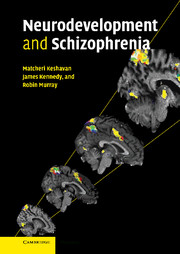Book contents
- Frontmatter
- Contents
- List of contributors
- Foreword
- Preface
- Part I Basic aspects
- Part II Etiological factors
- 6 Do degenerative changes operate across diagnostic boundaries? The case for glucocorticoid involvement in major psychiatric disorders
- 7 Velo-cardio-facial syndrome (deletion 22q11.2): a homogeneous neurodevelopmental model for schizophrenia
- 8 Can structural magnetic resonance imaging provide an alternative phenotype for genetic studies of schizophrenia?
- 9 Nutritional factors and schizophrenia
- 10 Schizophrenia, neurodevelopment, and epigenetics
- 11 Early environmental risk factors for schizophrenia
- 12 Transcriptomes in schizophrenia: assessing altered gene expression with microarrays
- 13 Is there a role for social factors in a comprehensive development model for schizophrenia?
- 14 How does drug abuse interact with familial and developmental factors in the etiology of schizophrenia?
- Part III Pathophysiology
- Part IV Clinical implications
- Index
- Plate section
- References
14 - How does drug abuse interact with familial and developmental factors in the etiology of schizophrenia?
Published online by Cambridge University Press: 04 August 2010
- Frontmatter
- Contents
- List of contributors
- Foreword
- Preface
- Part I Basic aspects
- Part II Etiological factors
- 6 Do degenerative changes operate across diagnostic boundaries? The case for glucocorticoid involvement in major psychiatric disorders
- 7 Velo-cardio-facial syndrome (deletion 22q11.2): a homogeneous neurodevelopmental model for schizophrenia
- 8 Can structural magnetic resonance imaging provide an alternative phenotype for genetic studies of schizophrenia?
- 9 Nutritional factors and schizophrenia
- 10 Schizophrenia, neurodevelopment, and epigenetics
- 11 Early environmental risk factors for schizophrenia
- 12 Transcriptomes in schizophrenia: assessing altered gene expression with microarrays
- 13 Is there a role for social factors in a comprehensive development model for schizophrenia?
- 14 How does drug abuse interact with familial and developmental factors in the etiology of schizophrenia?
- Part III Pathophysiology
- Part IV Clinical implications
- Index
- Plate section
- References
Summary
- Type
- Chapter
- Information
- Neurodevelopment and Schizophrenia , pp. 248 - 270Publisher: Cambridge University PressPrint publication year: 2004
References
- 2
- Cited by



